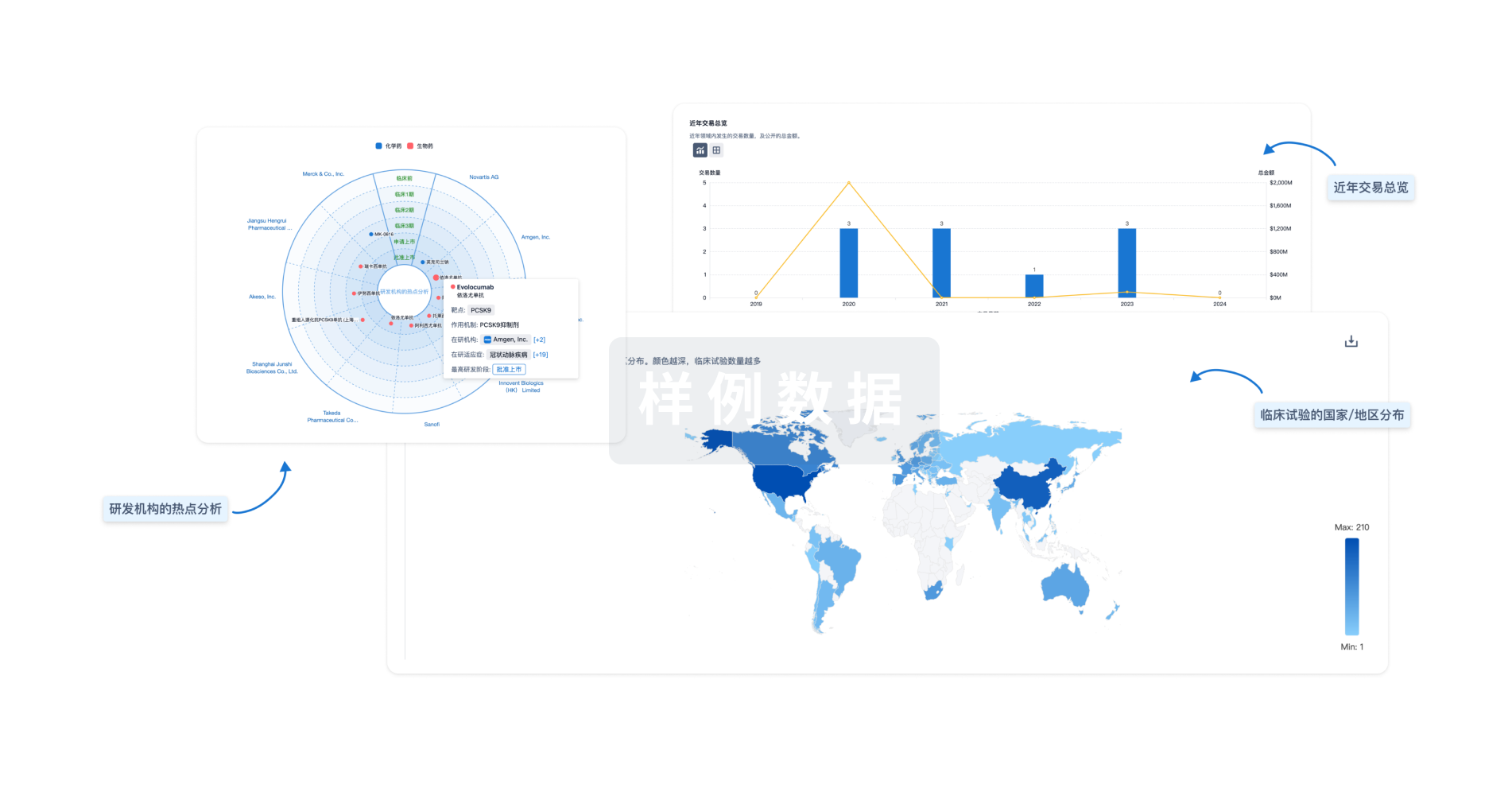预约演示
更新于:2025-05-07
CD37 x Tubulin
更新于:2025-05-07
关联
3
项与 CD37 x Tubulin 相关的药物作用机制 CD37拮抗剂 [+1] |
非在研适应症- |
最高研发阶段临床前 |
首次获批国家/地区- |
首次获批日期1800-01-20 |
作用机制 CD37拮抗剂 [+1] |
在研机构- |
原研机构 |
在研适应症- |
最高研发阶段终止 |
首次获批国家/地区- |
首次获批日期1800-01-20 |
作用机制 CD37拮抗剂 [+1] |
在研机构- |
原研机构 |
在研适应症- |
最高研发阶段无进展 |
首次获批国家/地区- |
首次获批日期1800-01-20 |
4
项与 CD37 x Tubulin 相关的临床试验NCT02564744
A Phase 2 Study to Evaluate the Efficacy and Tolerability of Debio 1562 in Combination With Rituximab in Patients With Relapsed and/or Refractory Diffuse Large B-Cell Lymphoma and Other Forms of Non-Hodgkin's Lymphoma
The primary purpose of the study was to determine the safety and tolerability, anti-tumor activity of the proposed Debio 1562 dose regimens in combination with rituximab.
开始日期2016-06-05 |
申办/合作机构 |
NCT02610062
A Phase 1 Study Evaluating Safety, Tolerability, and Pharmacokinetics of Escalating Doses of AGS67E Given as Monotherapy in Subjects With Acute Myeloid Leukemia (AML)
The purpose of this study is to evaluate the safety and tolerability of AGS67E in subjects with acute myeloid leukemia (AML) and determine a safe dose for future development. In addition, this study will assess the pharmacokinetics (PK), the immunogenicity, and the anti-leukemic activity of AGS67E.
开始日期2016-03-29 |
100 项与 CD37 x Tubulin 相关的临床结果
登录后查看更多信息
100 项与 CD37 x Tubulin 相关的转化医学
登录后查看更多信息
0 项与 CD37 x Tubulin 相关的专利(医药)
登录后查看更多信息
1
项与 CD37 x Tubulin 相关的文献(医药)2020-06-12·Journal of Biomolecular Structure and Dynamics
Functional study of 14-3-3 protein epsilon (YWHAE) in keratinocytes: microarray integrating bioinformatics approaches
Article
作者: Yin, Shang-Jun ; Lee, Bit-Na ; Hahn, Myong-Joon ; Kwak, Hyunchang ; Han, Ji-Won ; Yang, Jun-Mo ; Lee, Jae-Rin ; Park, Yong-Doo
2
项与 CD37 x Tubulin 相关的新闻(医药)2024-10-09
摘要:化学免疫疗法和细胞疗法是复发/难治性(R/R)淋巴瘤治疗的主要手段。这些治疗中出现的耐药性和常见毒性限制了它们在实现期望的响应率和持久缓解方面的作用。抗体-药物偶联物(ADC)是一种新型靶向疗法,已证明在治疗包括淋巴瘤在内的各种癌症中具有显著的疗效。迄今为止,已有三种ADC药物被批准用于不同类型的淋巴瘤,这标志着该领域取得了重大进展。在本文中,我们旨在回顾ADC的概念及其在淋巴瘤治疗中的应用,分析目前批准的药物,并讨论ADC开发正在进行的进展。
1.引言
淋巴瘤是一组来自不同类型淋巴细胞(B细胞、T细胞或自然杀伤(NK)细胞)在不同成熟阶段的克隆性增殖的恶性肿瘤。过去几十年来,不同类型淋巴瘤的发病率一直在增加。化学免疫疗法和细胞疗法仍然是不同亚型淋巴瘤常用的治疗手段。大多数化疗方案的治疗效果指数较窄,导致广泛的毒性。此外,耐药性的出现是最常见的原因之一,阻碍了它在复发和难治性(R/R)情况下的使用。针对表面抗原的单克隆抗体,如利妥昔单抗和奥比妥珠单抗,已经彻底改变了淋巴瘤的治疗。抗体-药物偶联物(ADCs)是一种高度靶向的药物,将针对特定表面抗原的单克隆抗体(mAb)与细胞毒素分子连接起来。毒素只传递给表达表面抗原的细胞,具有高度的肿瘤特异性和有限的系统暴露。美国食品药品监督管理局(FDA)已经批准了三种用于治疗淋巴瘤的ADC药物,分别是本妥昔单抗、波拉图单抗和洛卡图单抗。
在本文中,我们将回顾ADC的概念,重点关注它们的结构、工程和在淋巴瘤治疗中的作用。此外,我们将提供目前批准的ADC在这一设置中的综合分析,以及正在进行的进展的概述。这包括突出来自临床前和临床试验的有希望的结果,以及讨论下一代ADC开发的未来方向。
2.ADC的基本结构
ADC由抗体、药物(有效载荷或细胞毒素)和连接子组成。抗体结合恶性细胞表面表达的特定抗原。一旦结合,ADC被内化,细胞毒素有效载荷释放到细胞内,导致细胞周期终止和凋亡。在周围目标阴性细胞中也可以看到细胞毒性效应,当药物扩散到它们中并引起“旁观者杀伤”时,这是一种当有效载荷从被内化和降解的ADC释放或当药物释放到细胞外空间后从目标细胞释放时发生的细胞死亡。值得注意的是,为了获得更好的结果和更少的副作用,抗原和抗体之间的结合需要尽可能特异性。有效载荷的内化率、连接子的稳定性和相应抗体的选择是影响ADC在临床实践中使用的一些变量。
2.1. 单克隆抗体
选择合适的抗体是ADC工程中的关键步骤;它通常被设计为特异性结合癌细胞表面表达的目标抗原。理想的单克隆抗体应具有低免疫原性、低交叉反应性、长的血浆半衰期,以及对肿瘤细胞表面抗原的高结合亲和力。最常用的类别是免疫球蛋白G(IgG),更具体地说是IgG1亚型,因其血清稳定性。在ADC开发的早期阶段,主要使用小鼠来源的抗体。然而,这些抗体报告有很高的失败率,可能归因于它们缺乏临床效益,同时引起严重的免疫原性相关的不良效应。这些ADC也被人类抗小鼠抗体迅速清除,限制了它们的疗效。此外,这些早期ADC中使用的连接子在人体循环中不稳定,导致有效载荷过早释放,大大降低了效果并增加了毒性。自从出现显著降低免疫原性的人源化小鼠单克隆抗体以来,已经取代了小鼠抗体,导致更优化的设计,如2000年FDA批准的针对CD33阳性急性髓系白血病患者的首个ADC药物吉妥单抗奥佐米星。迄今为止,已有十四种ADC获得FDA市场批准,其中三种如前所述已获批准用于治疗淋巴瘤。其中,只有本妥昔单抗使用嵌合抗体。嵌合抗体是通过融合不同物种的域(例如,整个小鼠或兔的可变区与人类来源的恒定域)设计的。相比之下,人源化抗体含有嵌入人类来源的Fab区和恒定区的外来氨基酸段。因此,它们较少免疫原性,是更安全的选择。在全人抗体中,没有一部分是小鼠来源的,与人类化抗体相比,它们在免疫反应中的发生率更低;例如FDA批准的enfortumab vedotin。
2.2. 有效载荷
ADC的理想有效载荷应具有低免疫原性、长半衰期、小分子量、在抗体的水性环境中良好的溶解度、在循环和溶酶体中的高稳定性、体外亚纳摩尔半最大抑制浓度(IC-50)以及有助于与抗体结合的官能团,同时保持ADC的内化特性。每个抗体平均结合两到四个强效的细胞毒素分子。目前,ADC设计中最受欢迎的两类有效载荷是微管破坏剂和DNA靶向剂(图1)。
图1. 设计ADC时常用的十种不同有效载荷的分子结构
微管抑制剂可以根据它们的作用机制分为两大类。第一组包括微管稳定剂。这些药物通过抑制微管解聚和促进聚合来增强丝状体的稳定性,使丝状体功能降低。第二组由破坏微管的物质组成,阻止微管蛋白组装和成熟微管的发展。在ADC开发中使用和研究的主要微管抑制剂包括长春碱类、紫杉醇类、auristatins、美登素类、隐孔菌素、海葵素和圆盘菌素。auristatins如单甲基auristatin E (MMAE)通过阻止α-和β-微管蛋白单体聚合并触发凋亡来破坏微管并阻止细胞分裂。结合区域位于两个纵向排列的微管二聚体的β1-微管蛋白和α2-微管蛋白亚基之间。根据体外研究结果,auristatin-微管蛋白键合形成环状或螺旋形聚集体,改变微管的功能。长春碱类如长春新碱或长春碱,以及隐孔菌素和多拉斯他汀,诱导微管形成类似的弯曲结构构象。
在细胞周期的任何阶段,DNA损伤剂通过双链断裂、烷基化、插入和交联四种主要机制可以杀死癌细胞。最常用的DNA损伤有效载荷是卡利烯胺、二酮霉素、吡咯并苯并二氮杂环(PBD)、多柔比星和喜树碱类似物。针对BCL-2抑制剂、剪接体抑制剂和针对RNA聚合酶II的转录抑制剂等靶向药物是具有不同作用机制的额外有效载荷。
值得注意的是,根据FDA对15种含有PBD有效载荷的ADCs的肿瘤学分析,PBD有效载荷的毒性概况更高,这表明常见的不良事件包括可能的血管渗漏综合征、转氨酶升高、骨髓抑制、胃肠事件、代谢效应、肌肉骨骼事件、神经病变、呼吸困难和肾损伤,所有这些都源于PBD的非靶向输送;该分析表明,2013年至2017年间47%的PBD偶联ADCs的新药申请被中止。这些高效ADCs发生危及生命的毒性的更高发生率是一个限制。
目前减轻PBD毒性的机制包括药物-连接子组分的聚乙二醇化,这显著提高了ADC的耐受性。另一种机制是使用对氨基苄氧羰基(PABC)自毁间隔基,在连接臂-药物中;该间隔基具有稳定的二硫键,允许在细胞内快速释放自由有效载荷,从而实现更好的血浆稳定性和与可裂解连接臂相比提高的毒性。后一项研究认为,肽连接的和二硫键连接的PBD ADC在两种不同的淋巴瘤模型中提供了相似的疗效,并且二硫键连接的PBD ADC具有更好的安全性。第三种机制是通过减少PBD结构中的一个亚胺官能团进行化学修饰,从而将DNA交联的PBD二聚体转变为DNA烷基化代谢物,称为吲哚喹喔啉二聚体(IGN),这在小鼠肿瘤模型中实现了更有效的载荷释放,其中小鼠能够耐受更高剂量的IGN偶联ADC。
近期在有效载荷方面也取得了进展。主要的进展是免疫调节ADC,如干扰素基因刺激剂(STING)激动剂、Toll样受体(TLR)激动剂和使用蛋白酶体靶向嵌合体(PROTAC)策略的目标蛋白降解剂(TPD)。STING激动剂激活干扰素和其他细胞因子的产生,从而增强免疫和抗肿瘤反应。将STING激动剂作为有效载荷纳入ADC可以实现其向肿瘤目标的传递,具有更高的疗效和由于免疫激活导致的过度炎症反应而减少的毒性。STING激动剂的例子包括DMXAA、c-di-AMP、c-di-GMP、cGAMP、ADU-S100、MK-1454、SB11285、BMS-986301、E7766、MSA-1和MSA-2;它们主要在乳腺癌中被探索。TLR激动剂通过增强肿瘤微环境中抗原呈递细胞的抗原呈递,改善先天和适应性抗肿瘤免疫,从而促进更多细胞毒性T细胞的促进和活性。它们在局部癌症中发挥作用,例如,BCG(TLR2/4激动剂)用于膀胱非浸润性癌,AS04(TLR4激动剂)用于宫颈癌,以及咪喹莫特(TLR7激动剂)用于表皮基底细胞癌。目前,许多TLR激动剂正在作为ADC中的有效载荷在癌症免疫疗法中进行研究。一个例子是BDC-1001(TLR7/TLR8激动剂与抗HER2抗体偶联的ADC),在临床前模型中显示出有希望的结果。目前正在进行一项I/II期临床试验,该试验正在招募表达HER2的晚期实体瘤患者(NCT04278144)。PROTAC是一种催化作用于小剂量的催化剂,它通过泛素化介导的蛋白水解作用靶向特定的蛋白质。当PROTAC有效载荷与抗体偶联时,它会产生PROTAC催化行为和抗体的组织特异性的新型组合,具有更好的疗效和更少的限制。在表达HER2的细胞中存在成功的例子。这些在ADC设计中的微妙改进具有巨大的潜力,通过不断的研究可以为肿瘤学带来更好的结果,并为包括淋巴瘤在内的其他癌症类型的发展打开大门。
2.3. 化学连接臂
连接臂是成功开发ADC的最重要和最复杂的部分,因为它们形成了治疗和抗体之间的联系。它们的结合机制、稳定性和化学性质对于防止意外释放药物进入血流以及在癌细胞内吞后促进容易裂解至关重要,允许有效载荷仅在预期的地点释放。它们在确定ADC的药代动力学、药效学和治疗窗口方面至关重要。目前FDA批准的ADC使用两类连接臂,它们在有效载荷释放机制上有所不同:可裂解和不可裂解连接臂。最常用的四种可裂解连接臂是β-葡萄糖醛酸酶敏感连接臂、谷胱甘肽(GSH)敏感二硫键连接臂、卡他蛋白B敏感连接臂和腙连接臂。前面描述的旁观者效应,它影响肿瘤微环境中的正常细胞和没有或低目标表达的肿瘤细胞,更有可能发生在使用可裂解连接臂的ADC中。
不可裂解连接臂与可裂解连接臂相比,具有更好的血浆稳定性、较低的非目标毒性和抗蛋白水解降解的能力,因为它们与抗体的氨基酸残基具有不可还原的键。通常,不可裂解连接臂由硫醚或马来酰亚胺己酰基团形成。附着在由降解的抗体衍生的氨基酸残基上的不可裂解连接臂必须在ADC内化后,由细胞质和溶酶体蛋白酶完全分解抗体部分才能释放有效载荷。图2展示了一般的基本结构。
图2. ADC的一般基本结构。ADC由一个嵌合或人源化(免疫原性较低)的抗体组成,该抗体对淋巴瘤癌细胞表面表达的抗原具有强烈的结合活性。抗体应在循环中具有较高的半衰期,以便被输送到目标细胞表面。抗体与不同结构的有效载荷(主要是微管抑制剂或DNA相互作用)相连,这些是具有理想药物/抗体比例的高效药物。抗体与有效载荷之间的连接是通过可裂解或不可裂解的连接臂实现的,这些连接臂应具有精确的结合、在循环中的稳定性,并确保在目标处有效分配有效载荷。
3.FDA批准用于淋巴瘤的ADC
截至2023年,已有三种ADC获得了FDA对各种类型淋巴瘤的批准,分别是Brentuximab Vedotin(BV)、Polatuzumab Vedotin(PV)和Loncastuximab Tesirine(LT),如表1所示。
Brentuximab Vedotin(BV)由针对CD30的IgG1嵌合单克隆抗体“cAC10”和细胞毒素MMAE组成,它们通过一个稳定的连接臂(Cathepsin可裂解连接臂和对氨基苄基-羰基间隔基)结合在一起。嵌合单克隆抗体cAC10与CD30结合,随后通过内吞作用和随后与溶酶体的囊泡融合,在溶酶体中,溶酶体半胱氨酸蛋白酶裂解连接臂,释放MMAE直接进入癌细胞内,从而导致癌细胞毒性。抗体和MMAE之间的连接系统设计为在循环中稳定,由马来酰亚胺己酰基间隔基、蛋白酶敏感的二肽Val-Cit、自毁PABC基团以及二肽和药物之间的附加间隔基组成。后者具有自裂解的能力,并有助于卡他蛋白B进入其裂解序列。马来酰亚胺部分与抗体重链和轻链中的半胱氨酸残基的末端硫醇形成硫醚键,将连接臂连接到抗体。由蛋白酶裂解Cit-PABC酰胺键产生的不稳定PABC取代的MMAE中间体,通过自发的1,6-消除反应,产生自由的MMAE分子、CO2和对氨基苄基醇。值得注意的是,CD30在恶性淋巴瘤细胞上表达非常强,在正常组织上表达较少。与单独的抗体相比,BV可以使CD30+细胞系的生长停滞高达340倍。BV的结构和作用机制如图3所示。cHL的恶性Reed-Sternberg细胞以表达CD30为特征,CD30是肿瘤坏死因子超家族的成员,鉴于其对一小部分活化的B细胞、T细胞和嗜酸性粒细胞的表达限制,它代表了单克隆抗体治疗的理想靶点。BV在未经治疗的cHL患者和R/R疾病中表现出显著的活性,导致在这些情况下获得FDA批准。
图3. BV的结构和作用机制。它由一个针对淋巴瘤细胞上CD30抗原的单克隆抗体组成。结合后,整个ADC-抗原复合物被细胞内运输到溶酶体,在那里释放MMAE(有效载荷),干扰细胞核中的微管结构,导致细胞周期停滞和凋亡。
ECHELON-1 III期试验将1334名未经治疗的III期或IV期cHL患者随机分配接受BV-AVD(Brentuximab Vedotin、Adriamycin、Vinblastine、Dacarbazine)或ABVD(Adriamycin、Bleomycin、Vinblastine、Dacarbazine)。试验显示BV-AVD组的2年修正无进展生存期(PFS)为82%,而ABVD组为77%,风险比(HR)为0.77,6年总生存期(OS)分别为93.9%和89.4%,HR为0.59。基于ECHELON-1的结果,FDA批准BV与化疗联合用于成人未经治疗的III期或IV期cHL的治疗。最近,SWOG S1826试验被开发出来,比较BV-AVD与N-AVD(Nivolumab、Adriamycin、Vinblastine、Dacarbazine)对儿童和成人新诊断的晚期cHL(III期或IV期)患者的疗效。S1826研究表明,Nivo-AVD的1年PFS(94%)优于BV-AVD(86%),HR为0.48,并且两组的不良事件(AE)概况相当,因此它目前是未经治疗的cHL的一线治疗的首选方案。
尽管年轻患者更容易耐受多药化疗方案,但由于多种因素,包括合并症、身体状况差、无法耐受全剂量化疗以及治疗相关AEs增加,老年cHL人群的治疗结果较差。一项多中心II期研究评估了60岁及以上患者的序贯BV方案,随后进行AVD化疗,并在随后进行BV维持治疗。研究报告了84%的2年PFS率和93%的2年OS率。这种序贯方法提高了这一脆弱人群中cHL的治愈率,是新诊断cHL老年人的首选方案。
在R/R cHL环境中,BV最初在自体造血干细胞移植(ASCT)失败的患者中进行了研究。BV单药治疗显示总响应率(ORR)为75%,完全缓解(CR)为34%,中位无进展生存期(mPFS)为5.6个月。值得注意的是,CR患者的中位持续响应时间(mDOR)为20.5个月。这些结果导致BV首次获得FDA批准,用于治疗ASCT失败或至少两个先前的多药化疗方案失败的cHL患者。随后,AETHERA III期试验包括了接受过ASCT并具有以下不利风险之一的cHL复发难治性疾病患者,例如原发性难治性HL、初次缓解<12个月的复发HL,或一线治疗后复发时的结外受累。AETHERA研究表明,ASCT后早期巩固使用BV将mPFS提高到42.9个月,而对照组为24.1个月,HR为0.57。基于AETHERA试验,FDA随后扩大了BV的批准范围,用于治疗ASCT巩固后有高复发或进展风险的cHL患者。
除了前述的FDA批准外,BV还根据CheckMate 744 II期研究的结果,被国家综合癌症网络(NCCN)指南推荐与Nivolumab联合用于复发或难治性cHL患者的二线或后续治疗。该研究评估了涉及Nivolumab加BV,随后对次优反应患者使用BV加Bendamustine的风险分层响应适应方法。CheckMate 744研究表明,59%接受BV和Nivolumab治疗的患者,以及94%随后接受BV和Bendamustine治疗的患者,实现了完全分子反应(CMR)。这些结果明显优于历史上60至70%的CMR率,为R/R环境中的更高治愈率奠定了基础。
正在进行的BV在cHL的试验如图2所示。
BV在CD30阳性T细胞淋巴瘤中的作用
系统性间变性大细胞淋巴瘤(sALCL)中CD30的普遍表达,以及在外周T细胞淋巴瘤-未另行指明(PTCL-NOS)、血管免疫母细胞性T细胞淋巴瘤(AITL)和成人T细胞白血病或淋巴瘤(ATLL)等亚型中的高表达,为在T细胞淋巴瘤中靶向CD30提供了强有力的理由。
一项针对至少一种联合化疗方案失败后的R/R ALCL患者的II期研究显示,86%的患者实现了客观反应,其中57%为CR,mDOR为12.6个月。这项研究的结果导致FDA批准BV用于R/R PTCL。ECHELON-2试验旨在比较BV与环磷酰胺、多柔比星和泼尼松(A+CHP)联合使用与标准CHOP(环磷酰胺、多柔比星、长春新碱和泼尼松)治疗未经治疗的CD30阳性PTCL患者的疗效和安全性。A+CHP显示出48.2个月的mPFS,与CHOP的20.8个月相比,具有可比的安全性概况。5年PFS分别为A+CHP的51.4%和CHOP的43%(HR 0.7),5年OS分别为A+CHP的70.1%和CHOP的61%(HR 0.72),两组之间的安全性概况相当。随后的亚组分析显示,S-ALCL主要从A+CHP中受益,而AITL和PTCL-NOS亚组的益处尚不明确。
除了PTCL,BV在皮肤T细胞淋巴瘤(CTCL)中的作用也得到了探索。ALCANZA III期试验包括了接受过一线系统治疗的原发性皮肤间变性大细胞淋巴瘤(pcALCL)或表达CD30的蕈样真菌病(MF)的患者。在平均45.9个月的随访中,试验偏爱BV组,ORR为54.7%对12.5%,mPFS为16.7对3.5个月。同样,与医生选择相比,BV组的下一次治疗的中位时间显著更长(14.2对5.6个月;HR 0.27)。基于ALCANZA试验的结果,FDA批准BV用于治疗接受过先前系统治疗的pcALCL或表达CD30的MF患者。目前,BV正在许多早期阶段的试验中进行评估,这些试验包括在表2中。
波拉图珠单抗(PV)由一种抗CD79B的人源化IgG1单克隆抗体组成,通过一个可被蛋白酶裂解的马来酰亚胺己酰基-缬氨酸-PABC肽段连接臂与MMAE结合。一旦波拉图珠单抗与CD79b结合,它就会被内吞并通过内质网运输到溶酶体,在那里发生连接臂裂解,导致有效载荷释放到细胞内诱导凋亡。PV的结构和作用机制如图4所示。
图4. PV的结构和作用机制。PV由一个针对淋巴瘤细胞上的CD79b抗原的单克隆抗体组成。结合后,整个ADC-抗原复合物被内吞到内质体,并与溶酶体融合。然后连接臂被裂解以释放MMAE(有效载荷),这反过来导致细胞核中的有丝分裂停止和细胞死亡。
5.1. PV在弥漫大B细胞淋巴瘤中的应用
弥漫大B细胞淋巴瘤(DLBCL)是非霍奇金淋巴瘤(NHL)最常见的形式。虽然利妥昔单抗的加入显著提高了CHOP化疗的治愈率,但大约40-50%的患者最初反应后会出现难治性疾病或复发。
POLARIX是一项具有里程碑意义的III期研究,评估了PV加入R-CHP(利妥昔单抗、环磷酰胺、多柔比星、泼尼松)在DLBCL一线治疗中的疗效,并与R-CHOP进行了比较。POLARIX证明了pola-R-CHP组2年PFS为76.7%对70.2%,(分层HR 0.73)。两组的整体安全性概况相似。值得注意的是,pola-R-CHP的益处在60岁以上的患者、国际预后指数(IPI)在3到5之间的患者以及具有活化B细胞样亚型的DLBCL患者中观察到。相反,在60岁或以下的患者、有大量疾病、较低IPI评分或滤泡中心B细胞样亚型的DLBCL患者中没有明显益处。基于POLARIX试验,pola-R-CHP是第一个在DLBCL一线治疗中证明比R-CHOP具有更好PFS的方案,并获得了FDA对先前未经治疗的DLBCL、未另行指明(NOS)、高级别B细胞淋巴瘤(HGBL)或IPI评分为2或更高的患者的批准。
POLAR BEAR III期试验比较了mini-R-CHOP与pola-mini-R-CHP作为老年DLBCL患者的一线治疗。初步安全性数据显示,两种方案在老年人(69%在80至90岁之间)和脆弱人群中(16%脆弱,12%的ECOG表现状态为3)都是可耐受的,用波拉图珠单抗替代长春新碱并没有导致3到4级血液学毒性或神经病变的发生率更高。值得注意的是,pola-mini-R-CHP组的胃肠道不良事件频率更高(31%对16%)。基于POLARIX试验的结果,人们倾向于假设pola-mini-R-CHP可能显示出比mini-R-CHOP更好的PFS。因此,这项研究的结果备受期待。
在R/R DLBCL环境中,评估PV安全性和有效性的第一项试验是Ib/II期试验,该试验比较了PV与利妥昔单抗(R)和苯达莫司汀(B)联合使用与单独BR对不适合移植的R/R DLBCL的疗效。pola-BR组显示更高的CR(40%对17.5%),更长的mPFS(9.5对3.7个月,HR 0.36),以及更高的mOS(12.4对4.7个月,HR 0.42)。然而,它导致了更高比例的3到4级中性粒细胞减少症(46.2%对33.3%)、贫血(28.2%对17.9%)和血小板减少症(41%对23.1%),尽管3到4级感染的发生率相似(23.1%对20.5%)。与PV相关的周围神经病变在43.6%的患者中观察到,但大多数是1到2级并解决了。这项试验导致了2019年6月pola-BR的初步批准及其在这种情况下的广泛使用。
波拉图珠单抗的另一个有希望的组合在Ib/II期试验中得到证明,该试验结合了Mosunetuzumab,一种针对CD20和CD3的人源化IgG1双特异性抗体,在R/R DLBCL、HGBCL、转化的FL或3b级FL中。在平均23.9个月的随访中,59.2%的患者对波拉图珠单抗加Mosunetuzumab有反应,45.9%的患者达到了CR。mPFS为11.4个月,mOS为23.3个月。这种方案被良好耐受,最常见的AE是25%患者的中性粒细胞减少症。总的来说,这些结果表明波拉图珠单抗和Mosunetuzumab的组合可以在不适合移植的R/R LBCL中带来具有临床意义的反应和有利的安全性概况。
5.2. PV在其他B细胞非霍奇金淋巴瘤(B-NHL)中的应用
除了DLBCL,包括PV的联合疗法也在惰性B-NHL中进行了探索。在Ib/II期试验中,评估了波拉图珠单抗、奥比妥珠单抗(G)和来普尼(Len)联合治疗R/R FL的安全性和有效性。在平均27个月的随访后,结果显示ORR为76%,CR率高达63%,尽管没有达到预先设定的活性阈值。在平均43.3个月的随访后,mPFS和mOS尚未达到,而4年的里程碑PFS为53%。这些结果与R/R FL的现有标准化疗选择相当,并支持在FL中进一步研究Pola-G-Len方案。
PV的疗效也在套细胞淋巴瘤(MCL)中进行了研究。在一项针对R/R MCL的II期研究中,PV与Mosunetuzumab联合用于先前接受过两线或以上治疗的患者,包括布鲁顿酪氨酸激酶抑制剂(BTKi),并显示出75%的高ORR和70%的CR。然而,需要更多的结果数据来评估其在MCL中的作用,对于对化疗免疫疗法和BTKi耐药的患者迫切需要新的方案。
6.隆卡图珠单抗
CD19是一种在B细胞分化的最早阶段直到浆细胞发育过程中表达的表面糖蛋白。除了正常的B细胞,CD19也在大多数B细胞淋巴瘤中表达。与CD20相比,CD19表现出更均匀的表达,并在抗CD20靶向治疗后的小部分CD20阴性肿瘤中保留,使其成为免疫疗法和联合疗法的选择性靶点。隆卡图珠单抗(LT,ADCT-402)是一种ADC,由一种人源化抗CD19单克隆抗体组成,通过一个可被卡他蛋白裂解的连接臂与高度细胞毒性的DNA小沟交叉链接吲哚喹喔啉二聚体毒素(PBD二聚体)结合。由于其快速的内吞动力学、运输到溶酶体和在循环中的稳定性,LT是针对CD19最有效的ADC。LT的结构和作用机制如图5所示。
图5. LT的结构和作用机制。LT由单克隆抗体Loncastuximab通过可裂解连接臂(统称为Tesirine)与PBD二聚体(有效载荷)相连。该抗体与淋巴瘤细胞上的CD19抗原结合,之后整个复合物被内吞并合并到溶酶体中。接着,PBD被释放到细胞质中,它移动到细胞核,在那里发生DNA交叉链接,导致细胞死亡。
6.1. LT在弥漫大B细胞淋巴瘤中的应用
LT在人体I期研究中显示出对R/R NHL具有临床意义的活性,这导致了LOTIS-2研究,该研究评估了其在R/R DLBCL中的疗效。LT显示出48.3%的ORR,其中50%的应答者达到了CR。虽然mPFS为4.9个月,但达到CR者的mDOR为13.4个月。它展示了通常被良好耐受的安全概况,中性粒细胞减少症是最常见的3级AE(26%),其次是血小板减少症(18%)和γ-谷氨酰转移酶升高(17%)。显著的抗肿瘤活性、持久的反应和可接受的安全概况导致了2021年FDA批准用于治疗经过两线或以上系统治疗后的R/R大B细胞淋巴瘤。批准包括那些有DLBCL NOS、由低级别淋巴瘤引起的DLBCL和HGBL。
在具有里程碑意义的LOTIS-2研究之后,LT与其他靶向疗法的组合,如LOTIS-3中的ibrutinib和LOTIS-5中的单克隆抗CD20抗体rituximab对R-GemOX(利妥昔单抗、吉西他滨和奥沙利铂)进行了评估,但目前尚不清楚这些组合是否会进入临床应用(表2)。
6.2. LT在滤泡性淋巴瘤中的应用
LT在复发/难治性非霍奇金淋巴瘤(R/R NHL)的I期研究中进行了评估,其中在滤泡性淋巴瘤(FL)中显示了78.6%的客观反应率(ORR)。在2023年美国血液学会(ASH)会议上,最近展示了将LT与利妥昔单抗联合应用于R/R FL的II期试验的非常鼓舞人心的结果。该试验显示了95.2%的客观反应率,其中包括66.7%的完全缓解(CR)和28.6%的部分缓解(PR)的比率。
7.其他正在研究、开发和评估用于治疗淋巴瘤的抗体药物偶联物
7.1 针对CD19的抗体药物偶联物
7.1.1 科尔图珠单抗拉伐坦辛
科尔图珠单抗拉伐坦辛(SAR3419)是一种IgG1抗体(huB4),通过二硫键交联剂SPDB与细胞毒素药物DM4相连,靶向CD19。CD19是一种在血液形成分化过程中的B淋巴细胞系高度表达的蛋白,从早期B细胞到成熟B细胞,并在大多数B细胞恶性肿瘤中保持表达。两项II期试验已经研究了科尔图珠单抗拉伐坦辛作为单药或联合用药的使用。一项正在进行的试验正在检查其在R/R DLBCL患者中单药治疗的使用,初步数据显示ORR为44%;然而,mPFS、mOS和DOR尚未得出。它具有可接受的安全性概况,药物在41名患者中有4名因不良事件而中断。另一项试验检查了科尔图珠单抗拉伐坦辛与利妥昔单抗联合用于DLBCL患者,显示出ORR为31.1%,在复发疾病患者中疗效最高(ORR 58.3%),与难治疾病(ORR 43%)或一线治疗(ORR 15.4%)形成对比。总体而言,它显示出mPFS为3.9个月,mOS为9个月,DOR为8.6个月。
7.1.2 德尼珠单抗马佛多汀
德尼珠单抗马佛多汀(SGN-19A或SGN-CD19A)是另一种针对CD19的ADC。它是一种抗体(hBU12-491),通过不可裂解的马来酰亚胺己酰基连接臂与MMAF偶联。一项主要纳入了B-ALL患者(n = 59)的I期试验,以及侵袭性B细胞淋巴瘤(n = 6)和伯基特白血病/淋巴瘤(n = 6),显示DOR为27个月。每3周给药一次,在B-ALL中显示CRc(CR+CRi+CRp)为35%。在六名伯基特白血病/淋巴瘤患者和六名B-LBL患者中,每组只有一名达到CR。最常见的AEs是发热(54%)和恶心(52%)。另一项主要纳入了R/R DLBCL(n = 53),以及MCL(n = 5)和FL(n = 3)的I期试验,与前一次试验相比,在DLBCL中显示出略高的活性,ORR为33%,CR为22%,复发病例的DOR为39周,难治病例为41周。最常见的AEs与眼睛相关:视力模糊(65%)和干眼(52%)。德尼珠单抗马佛多汀在两项II期试验中进一步与化疗联合研究,一项将其与RICE化疗联合用于R/R DLBCL或3B级FL,与单独RICE进行比较,而另一项研究了其与R-CHOP或R-CHP联合对照R-CHOP单独作为DLBCL或3B级FL的一线治疗;然而,这两项试验都被赞助商终止。
7.2 针对CD22的抗体药物偶联物
7.2.1 伊诺珠单抗奥佐加霉素
CD22是一种135 kDa的I型跨膜糖蛋白,是一种在未成熟和成熟B细胞上表达的B细胞系特异性蛋白。它在B细胞恶性肿瘤包括大多数淋巴瘤和白血病中上调表达。目前有两种针对CD22的ADC正在淋巴瘤中进行研究。第一种是伊诺珠单抗奥佐加霉素(CMC-544),一种IgG4 kappa单克隆抗体,带有N-乙酰-γ-卡利奇霉素二甲基肼,一种卡利奇霉素的半合成衍生物,通过4'-乙酰苯氧基丁酸连接,于2017年8月获得FDA批准用于R/R B细胞ALL。一项I期试验研究了其在R/R B细胞NHL患者中的应用,显示79名入组患者的ORR为39%,在FL中为68%,在DLBCL中为15%。然而,DOR很短,DLBCL的mPFS为10.4个月,FL为49天。患者中有90%出现最常见的AE,即血小板减少。一项针对顽固性B细胞NHL(n = 81)的II期试验显示了类似的结果,ORR为67%,CR为31%,mPFS为12.7个月。
7.2.2 匹那珠单抗韦德汀
匹那珠单抗韦德汀(Pina,DCDT2980S,RG-7593)是一种抗CD22的单克隆IgG1抗体,通过可裂解的马来酰亚胺己酰基-缬氨酸-PABC连接臂与MMAF偶联。一项I期试验显示,与利妥昔单抗联合使用相比,作为单药治疗使用时显示出更高的疗效,DLBCL组的ORR分别为25%和17%。在慢性淋巴细胞性白血病(CLL)中未见客观反应。在II期试验ROMULUS中进一步检查了其与利妥昔单抗的联合使用,与R-pola相比,在DLBCL患者中显示出更优越的反应,但在FL患者中没有;DLBCL队列在R-Pina(n = 42)上显示ORR为60%,CR为26%,而R-Pola(n = 39)上为ORR 54%,CR 21%。在这项试验中,两者的AEs相当,R-pina组DLBCL队列的3-5级AEs为79%,R-Pola为77%。在FL队列中,AEs略低,R-Pina和R-Pola的3-4级AEs分别为62%和50%。
7.3 针对CD25的抗体药物偶联物
卡米达卢单抗特西林
CD25是一种I型跨膜蛋白,是白细胞介素-2受体α链,是一种在活化的B细胞、活化和调节性T细胞以及髓系前体上表达的蛋白,在包括淋巴瘤和白血病在内的各种肿瘤中过度表达。卡米达卢单抗特西林(ADCT-301,HuMax-TAC)是一种IgG1单克隆抗体,通过可被卡他蛋白裂解的缬氨酸-丙氨酸二肽连接臂与PBD二聚体弹头(SG3199)偶联。一项I期试验检查了其在R/R cHL(n = 133)和R/R NHL(n = 56)中的疗效,其中在cHL患者中显示出71%的优越ORR和42%的CR,与R/R NHL相比(ORR 38%和CR 9%)。3级及以上AEs包括GGT水平升高(15%)、皮疹(12%)和贫血(11%)。更重要的是,3.8%的患者出现了严重的神经系统事件,包括吉兰-巴雷综合征(GBS)/多神经根病变,27.4%的患者因不良反应而中断治疗。尽管研究报告的CR令人鼓舞,但FDA建议不要提交用于治疗R/R HL的批准文件,因此其未来仍不明朗。
7.4 针对CD37的抗体药物偶联物
纳拉图珠单抗艾美曲辛
CD37是一种参与细胞膜组织和共刺激信号的跨膜蛋白,主要在成熟B细胞上表达,在T细胞、巨噬细胞/单核细胞和粒细胞上表达较少。它在成熟的B细胞恶性肿瘤中高度表达,如CLL,在DLBCL中表达不一,CD37阳性范围从40%到90%的病例,而在急性淋巴细胞性白血病(ALL)和HL中低表达或缺失。纳拉图珠单抗艾美曲辛(IMGN529)是一种IgG1单克隆抗体,通过硫醚连接臂N-succinimidyl-4-(N-maleimidomethyl) cyclohexane-1-carboxylate (SMCC)与美登木素DM1偶联,靶向CD37。
纳拉图珠单抗艾美曲辛最初在R/R B细胞淋巴瘤的I期试验中研究,结果显示最小的效果,总有效率(ORR)为13%。然而,纳拉图珠单抗艾美曲辛与利妥昔单抗联合的II期试验结果显示,在DLBCL中ORR更高,达到44.7%,完全缓解(CR)为31.6%,在FL中的响应率略高,ORR为57%,CR为36%。在中位随访15个月和21.8个月时,DLBCL和FL亚组的中位持续缓解时间(mDOR)尚未达到。治疗总体上被良好耐受,如在FACT-Lym QoL的淋巴瘤子量表上平均提高了三点的生命质量(QoL)测量所示。总体而言,目前尚不清楚它是否会进入III期研究。
7.5 针对CD70的抗体药物偶联物
Vorsetuzumab Mafodotin
CD70是一种共刺激分子,也是肿瘤坏死因子超家族的成员,它在抗原激活的B细胞、T细胞、NK细胞和成熟的树突状细胞上短暂表达。它在实体瘤和血液学恶性肿瘤中异常表达。Vorsetuzumab Mafodotin (SGN-75)是一种ADC,靶向CD70分子和微管毒素分子,连接到单甲基奥瑞斯他汀F(MMAF)。在R/R CD70+ NHL的I期试验中显示出不可接受的毒性,主要是血小板减少症。此外,SGN-CD70A是一种通过稳定、可被蛋白酶裂解的肽基连接臂与PBD二聚体偶联的工程半胱氨酸单克隆抗体(EC-mAb),靶向CD70。同样,它也与不可接受的毒性相关,并且只有适度的活性。
7.6 针对ROR1的抗体药物偶联物
7.6.1. Zilovertamab Vedotin
ROR1是一种酪氨酸激酶跨膜受体,表达在未成熟的B淋巴细胞、内分泌腺和小肠上。它在血液学恶性肿瘤中高度表达,尤其是B细胞淋巴瘤。Zilovertamab Vedotin (MK 2140或VLS-101)是一种针对ROR1的人源化IgG1单克隆抗体,通过可被蛋白酶裂解的连接臂与MMAE偶联。在一项具有里程碑意义的I期试验中,Zilovertamab Vedotin在R/R MCL患者中显示出47%的ORR,CR为20%,在R/R DLBCL患者中ORR为60%。II期waveLINE-004研究,将Zilovertamab Vedotin作为R/R DLBCL的单药治疗,显示出略低的疗效,ORR为30%,有10%的患者实现了CR。最常见的3-4级AEs是中性粒细胞减少症(18%),其次是贫血(15%)。目前有额外的研究正在进行招募;一项是将Zilovertamab Vedotin与R-CHP联合用于DLBCL的前线治疗的II期试验,另一项是评估其与R-GemOX联合对照R-GemOX单独用于R/R DLBCL的II/III期研究。
7.6.2. Cirmtuzumab-ADC-7
另一种针对ROR1的ADC是Cirmtuzumab,一种针对ROR1的单克隆抗体,通过UC-961连接臂与MMAE偶联。在I/II期,Cirmtuzumab与ibrutinib联合用于R/R MCL或治疗未经验(TN)或R/R CLL的管理。在MCL队列中,Cirmtuzumab显示出80%的ORR,35%的患者实现了CR。值得注意的是,在中位随访14.9个月时,mPFS尚未达到。在CLL队列中,结果随着成熟仍然令人鼓舞,TN和R/R CLL患者的mPFS在中位随访14个月和7个月时也未达到。总体而言,该研究正在进行中,结果看起来很有希望。
7.7 临床前开发中的ADCs
7.7.1. 新型CD30靶向ADC:SGN-35C
SGN-35C在组成上与BV相似,都是抗CD30抗体,但在连接臂上有所不同,它连接的是一种新型的喜树碱衍生的拓扑异构酶1抑制剂有效载荷。在CD30阳性ALCL和HL细胞系上进行的体外和体内研究,包括那些对BV有抗性的细胞系,显示出治疗诱导的细胞毒性。值得注意的是,这种效果扩展到了CD30阴性细胞,表明了旁观者效应。非人灵长类动物模型也证实了其安全性。下一步是人类临床试验,目前正在计划中。
7.7.2. CD19靶向ADC:IKS03
IKS03由一种针对CD19的人源化抗体组成,设计用于位点特异性结合PBD前药有效载荷。它通过生物结合激活,产生一种药物与抗体比率为2的偶联物。体外和体内研究已经证明了其在多种CD19阳性淋巴瘤细胞系中的有效细胞毒性,最值得注意的是在含有经常在R/R NHL中观察到的遗传异常的MCL和DLBCL异种移植模型中,如CCND1 t(11;14)易位和三重打击淋巴瘤,涉及BCL-2、BCL-6和c-MYC的基因重排。此外,与其他使用PBD前药的ADC相比,它展示了更低的非特异性有效载荷从偶联物中的释放率,包括LT。目前正在进行I期临床试验NCT05365659,以评估其在晚期B细胞NHL患者中的安全性。
7.7.3. CXCR5靶向ADC:VIP924
VIP924是一种首创的ADC,靶向CXCR5,由一种可被legumain裂解的连接臂和一种微管蛋白抑制剂(KSPi)有效载荷组成。CXCR5是一种趋化因子受体,在B细胞和T细胞来源的淋巴瘤上高度表达,并参与调节肿瘤细胞侵袭、生长和迁移的途径。一项体内研究比较了VIP924与PV和LT在MCL的人性化小鼠模型中的效果。结果表明VIP924在抑制肿瘤生长、提高存活率和耐受性方面的优势。值得注意的是,与LT不同,VIP924组的动物没有经历细胞减少症。这些有希望的结果支持在人类临床试验中进行进一步研究的需求。
8.ADCs的未来发展方向
最近在设计位点特异性ADCs、利用双特异性抗体以及修改可裂解连接臂方面取得了进展,以期使ADCs更有效、更高效,同时最小化毒性。一种新颖的偶联化学方法涉及位点特异性附着,其中一些技术利用抗体中的天然链间二硫键,而其他技术则需要生物工程将酶促偶联标签整合到抗体序列中。尽管在淋巴瘤中尚未探索,但位点特异性偶联已在实体恶性肿瘤(如乳腺癌、卵巢癌和胰腺癌)中得到评估。其中一种应用是ThioMab技术,它涉及使用工程化半胱氨酸进行位点特异性偶联。使用这种技术生产的ADC包括抗MUC16 ADC,它由在曲妥珠单抗的轻链和重链的特定位置插入半胱氨酸残基组成,然后与MMAE上的硫醇基团结合。此外,pClick技术提供位点特异性偶联;然而,它使用天然抗体和近距离激活的交联剂,不涉及任何生物工程。ThioBridge技术包括一种可裂解的连接臂,也使用天然抗体,并由三碳桥接附着提供增强的稳定性。此外,最近创新的AJICAP第二代技术通过利用硫酯化学的选择性裂解反应,实现了无聚集挑战的位点特异性ADC的生产,并有望成为无需抗体工程的位点特异性ADC。最后,通过不同的方法(如糖基重塑、转谷氨酰胺酶或脂酸连接酶方法)对天然抗体进行无标签酶促修饰,作为推进ADC发展的潜在工具具有潜力。
一类有前景的ADCs由双价双特异性抗体组成,如在HER-2靶向ADC中所示。双特异性抗体靶向两个不重叠的表位,随后诱导受体聚集和内化。这类ADCs已在乳腺癌中显示出疗效,并且在临床前研究中检查了MET过表达肿瘤,提供了有效的细胞毒性。
关于连接臂的最新进展,工作集中在制造稳定以避免非目标有效载荷释放的连接臂,但也容易在目标部位裂解以有效传递。这导致制造具有pH和微环境依赖性裂解的连接臂,允许ADCs在细胞内释放有效载荷。
这些进展正处于开发或临床前阶段研究中,有望提高下一代ADCs在包括淋巴瘤在内的各种癌症中的治疗效果。
9.结论
ADCs是革新了霍奇金和非霍奇金淋巴瘤治疗的新方法。抗体、连接臂和有效载荷的进步将导致ADCs的进一步发展,对淋巴瘤具有更高的特异性和细胞毒性。虽然获得抗性将是一个限制因素,但与其他新型药物的联合疗法,如单克隆抗体、分子靶向疗法和双特异性抗体,将为新的突破性治疗铺平道路。我们迫切需要创新的I期研究,以更好地理解ADCs在不同疾病环境中的作用,因为我们的目标是提高淋巴恶性肿瘤的治愈率。
抗体药物偶联物免疫疗法细胞疗法
2022-06-06
·药智网
近日,2022年美国临床肿瘤学会(ASCO)年会在美国芝加哥开启。根据ASCO官网摘要信息及各家公司官方发布新闻稿统计显示,2022 ASCO大会上,我国共有超过50家药企的近240项研究中稿,并有19项目入选2022 ASCO大会口头报告,充分体现了我国本土药物研究的含金量和国际学术界认可度。今日,让我们一起对2022 ASCO上展示的创新项目进行盘点,对标国际前沿,侧重盘点我国创新药企的最新研究。图片来源:ASCO官网关键数据出炉,双抗争霸赛一触即发本次ASCO年会,多种新型治疗模式正向披露最新临床研究成果,双抗、ADC、细胞疗法、小分子抑制剂均有重要推进,指示全球药物最新研发动态。其中,双抗赛道的竞争尤为明显,又以PD-(L)1×CTLA-4双抗的研究结果最为亮眼。康方生物的AK104是目前进度最快的一款基于免疫检查点的双抗。在2022 ASCO大会上,康方生物披露了AK104联合标准化一线疗治疗持续性、复发性或转移性宫颈癌(R/M CC)的一项2期临床数据(NCT04868708)。研究结果显示,AK104联合标准治疗方案,在R/M CC患者中具有良好的抗肿瘤活性且耐受性良好。康宁杰瑞在研的KN046作为靶向PD-1/PD-L1和CTLA-4的双特异性抗体,其相关研究备受瞩目。在本次ASCO年会上报告了KN046应用于肝细胞癌(HCC)的2期研究结果(NCT04542837)。研究结果显示,作为晚期不可切除或转移性HCC患者的一线治疗,KN046联合仑伐替尼在患者ORR和PFS方面表现较好,且安全性可控。研究结果为KN046联合仑伐替尼作为此类患者的潜在治疗新选择提供了证据支持。齐鲁制药在本次ASCO会议上披露了QL1706疗法的相关数据。QL1706严格意义上不受双特异抗体,而是PD-1和CTLA-4联合疗法(PD-1 IgG4+CTLA4 IgG1),其是利用齐鲁的MabPair组合抗体技术平台。本次披露的数据为QL1706用于晚期鼻咽癌的疗效和安全性:来自1a/1b期试验的汇总队列结果。除上述双抗外,在PD-L1/TGF-β双抗领域,恒瑞医药、普米斯生物分别公布了SHR-1701、PM8001的早期临床数据;在HER2×HER2双抗领域,百济神州、康宁杰瑞分别公布了Zanidatamab、KN026的早期临床数据。此外,康方生物还公布了PD-1/VEGF双抗AK112的2个早期临床数据、信达生物公布了CD137/PD-1双抗IBI319的数据。不止胃癌,ADC探索新方向本次ASCO年会上,ADC领域的国内企业报道依旧聚焦在HER2领域,参与的企业有荣昌生物、乐普生物、科伦药业等,但在适应症上,已开始探索新方向,其中主要报道的瘤种为尿路上皮癌(UC)与乳腺癌。荣昌制药:尿路上皮癌荣昌制药的维迪西妥单抗,2021年6月9日,成功获批胃癌治疗适应证,成为了我国首个上市的民族原研ADC。仅半年后,2022年1月6日维迪西妥单抗又获得NMPA批准第二个适应症,用于治疗HER2表达的局部晚期或转移性UC,为临床诊疗带来了全新改变。在2022 ASCO年会上公布维迪西妥单抗有3项临床研究被选中纳入今年壁报讨论环节,且在同一时段构成维迪西妥单抗治疗尿路上皮癌的专题讨论,分别是:1)维迪西妥单抗与特瑞普利单抗联合治疗局部晚期或转移性尿路上皮癌的1b/2期联合研究初步结果;2)维迪西妥单抗在HER2阴性(免疫组化检查结果为0或1+)局部晚期或转移性尿路上皮癌中的2期临床研究;3)维迪西妥单抗治疗HER2过表达(免疫组化检查结果为2+或3+)转移性尿路上皮癌C005、C009临床试验的综合分析。此外,维迪西妥单抗泛瘤种新治疗模式也亮相了本次大会,即维迪西妥单抗联合放疗与免疫治疗HER2表达晚期难治性实体瘤的研究(布拉格3.0研究)首次公布了初步研究结果。乐普生物:尿路上皮癌另外,乐普生物在本次ASCO年会上公布MRG-002在UC适应症的研究结果。在一项单臂、多中心的2期研究中,MRG002的初步结果表明,在经过治疗的HER-2阳性不可切除的局部晚期或转移性UC患者中,MRG002具有一定的疗效,安全性可控,进一步的评估还在进行中。科伦药业:乳腺癌科伦药业则积极探索HER2 ADC在乳腺癌中的治疗前景。A166为靶向HER2 ADC药物,通过蛋白酶可裂解连接子将新型毒素分子(Duo-5,微管蛋白抑制剂)定点偶联至HER2抗体(曲妥珠单抗)。A166的1期临床研究数据入选2022 ASCO壁报。试验结论显示:A166既往证明的临床获益、安全性维持不变,在多线经治的HER2阳性转移性乳腺癌患者中,A166具有可控的毒性和值得期待的抗肿瘤活性。华东医药:卵巢癌此次ASCO年会上,华东医药将报告其叶酸受体(FRα)ADC药物Mirvetuximab Soravtansine(IMGN853)在FRα高复发性卵巢癌中的2期试验。在该项开放标签、多中心临床研究 (NCT04274426)中,17名患者ORR为71%,中位PFS为15个月,在FRα高表达的亚组中的ORR为80%。目前,该疗法已向FDA申请BLA,前不久被授予优先审评资格,有望成为全球第15款获批上市的ADC药物。打破内卷,细胞疗法进击实体瘤经过多年发展,细胞疗法已经成为癌症研究最热门的领域之一,其在血液瘤的治疗中取得的成就尤为振奋人心,让许多肿瘤患者看到了“治愈”的希望。在今年的ASCO会议放出的摘要中,我们看到各大本土biotech药企在实体瘤中的研究成果也频现曙光,成为攻克癌症的又一把利剑。原启生物:多发性骨髓瘤原启生物公布了其GPRC5D CAR-T疗法OriCAR-017在复发/难治多发性骨髓瘤患者中进行的首次人体1期研究结果。研究结果显示,OriCAR-017在多发性骨髓瘤患者中显示了良好的安全性和显著的疗效,大部分的AEs是暂时的和可控制的,100%ORR和100%MRD阴性率以及良好的安全性支持OriCAR-017成为一种具有竞争力的治疗方法。值得注意的是,之前BCMA CAR-T治疗复发的患者仍可受益于OriCAR-017。亘喜生物:多发性骨髓瘤GC012F是一款BCMA/CD19双靶点CAR-T产品,最新数据显示,该疗法完全缓解率近100%。该候选产品依托于亘喜生物专有的FasTCAR平台技术,具备“次日完成生产”的优势,于2021年11月被美国FDA授予孤儿药资格认定,用于治疗多发性骨髓瘤。在本次ASCO会议上,亘喜生物带来了一项在复发性/难治性多发性骨髓瘤患者中评价BCMA/CD19双靶向自体CAR-T细胞疗法GC012F的多中心、首次人体研究的更新结果。研究结果显示:截至2022年1月26日,28例患者接受了疗效评估,中位随访时间为6.3个月(范围1.8-29.9个月);目前,该研究仍在对患者进行持续随访,以评估缓解深度。斯丹赛:结直肠癌斯丹赛基于自主研发的CoupledCAR®平台技术构建了靶向GUCY2C的CAR-T细胞疗法GCC19CART,用于治疗复发/难治性结直肠癌(R/R mCRC)患者。2021年8月获得了美国FDA的临床试验批件,并于2022年4月获得FDA授予的快速通道资格。在此次ASCO会议上,斯丹赛将报告GCC19CART中国IRB临床试验中2个剂量爬坡试验组纳入的21例受试者的数据。截至2022年5月3日,13名受试者被纳入1级剂量组(1x10^6 cells/kg),8名受试者被纳入2级剂量组(2x10^6 cells/kg)。两种剂量水平的总体客观缓解率(ORR)为28.6%;3个月内疾病控制率(DCR,即使用药物后,肿瘤的体积不再增长)为100%。科济药业:胃癌科济药业开发了全球首个针对Claudin18.2的CAR-T细胞疗法--CT041。今年5月,CT041疗法最新1期试验中期结果在《Nature Medicine》在线发表,结果显示CT041具有显著的疗效和出色的耐受性,代表着中国团队率先攻破了CAR-T疗法在实体瘤中的瓶颈。在本次ASCO会议上,科济药业将进一步发布CT041治疗晚期胃癌/胃食管结合部腺癌的1b/2期研究结果和针对胰腺癌的1b期数据。值得一提的是,临床试验入组患者是“既往接受过至少二线治疗失败的Claudin18.2表达阳性的晚期胃癌/食管胃结合部腺癌(GC/GEJ)”,属于临床上难以治疗的晚期患者。香雪制药:软组织肉瘤香雪制药拥有高亲和力TCR-T技术,并基于技术开发出了TCR-T细胞治疗产品TAEST16001。其1期临床试验入选了今年ASCO会议的口头报告。该临床试验是一项开放、单臂、剂量递增和扩展研究,旨在评估TAEST16001在软组织肉瘤患者中的安全性、耐受性、PK、PD和初步疗效。结果显示,在12例疗效可评估的患者中,5例部分缓解,5例疾病稳定,2例疾病进展,总体响应率为41.7%。总体而言,TAEST16001表现出可接受的耐受性,支持该产品在晚期软组织肉瘤中的持续扩增研究。新兴免疫靶点标志新方向近年来,PD-1、PD-L1的“内卷”已经进入尾声,其他新兴肿瘤免疫靶点成为“新大陆”。在本次ASCO年会,我们发现国内biotech公司在BTLA、LAG-3、CD73等新靶点上更新了最新临床数据。君实生物:BTLAB和T淋巴细胞衰减子(BTLA)作为一种免疫检查点分子,与其他免疫检查点分子如PD-1和CTLA-4具有类似的结构和相近的细胞内的信号传导机制;其不仅在T细胞表面表达,同时也在B细胞、NKT细胞和树突状细胞中表达,通过与其配体结合传递抑制信号,在机体的免疫调控中发挥负调控作用。2022 ASCO年会上,君实生物公布了其自主研发的靶向BTLA的重组人源化IgG4单克隆抗体Icatolimab(TAB004/JS004),单药治疗晚期实体瘤患者的1a期剂量递增研究结果,以及单药或与特瑞普利单抗联合治疗复发/难治性淋巴瘤的1期研究结果。研究结果显示:Icatolimab单一疗法在所有评估的剂量中均具有良好的耐受性,并显示出作为单一疗法的初步临床疗效。Icatolimab联合toripalimab(抗PD-1)用于治疗晚期实体瘤患者目前正在进行中。Icatolimab单独或与toripalimab联合在所有评估的剂量中均具有良好的耐受性,并在复发/难治性淋巴瘤患者中显示出初步的临床疗效。信达生物:LAG-3IBI110是信达生物研发的重组全人源抗LAG-3单克隆抗体。继去年ASCO上首次发布了IBI110的1a/1b期临床数据,信达在今年ASCO年会上发布更新数据,并公布在两个癌种上的1b期临床初步数据:胃及胃食管交界处癌、鳞状非小细胞肺癌。试验结论显示:IBI110单药或联合信迪利单抗均表现出可接受的安全性和值得期待的抗肿瘤活性。维立志博:LAG-3LBL-007是由维立志博自主研发的一种IgG4亚型全人源单克隆抗体。在今年ASCO年会上,维立志博公布了LBL-007联合君实生物PD-1单抗特瑞普利单抗治疗不可切除或转移性黑色素瘤的1期临床结果。公开的摘要数据显示,LBL007与特瑞普利单抗联合用药在不可切除或转移性黑色素瘤患者中具有良好的耐受性和有希望的疗效,尤其是在未接受抗PD-(L)1治疗的肢端型黑色素瘤患者中。天境生物:CD37在2022 ASCO年会上,天境生物公布了CD73抗体尤莱利单抗与特瑞普利单抗联用治疗非小细胞癌(NSCLC)2期临床积极数据,并预计于2023年启动3期临床研究。数据显示:尤莱利单抗单药治疗或联合治疗均展现出良好的安全性和耐受性,未观察到剂量限制性毒性(DLT)事件。在一组不适合标准治疗的晚期NSCLC患者中观察到积极的疗效信号。临床数据证实疗效反应与肿瘤的CD73表达高度相关,进一步提示CD73可作为预测性生物标志物。此外,天境生物还公布了截至2022年3月29日最新的2期临床研究数据。最新数据显示,在三组治疗情况不同的NSCLC患者队列中,在一组不适合标准治疗的晚期NSCLC(大部分处于肺癌四期)患者中观察到了积极的疗效信号。启 示近几年,政策刺激下资本涌入,国内迎来创新大风口。在良好的政策环境与资本推动下,国内创新崛起加速。国产创新药陆续进入收获期,未来几年将看到更多重磅创新产品在国内陆续获批上市。但不可忽视的是,政策给予“泛泛创新”的时间窗口越来越短,医保控费趋严、赛道日益拥挤,行业已经慢慢进入到“精选优质创新”的时刻。未来同质化竞争将持续白热化,同质化产品将逐渐失去竞争力,而新技术、稀缺的技术平台、差异化的治疗领域、创新地给药方式等都可能会给企业带来更好的竞争格局,有技术沉淀的公司有望脱颖而出。声明:本文观点仅代表作者本人,不代表药智网立场,欢迎在留言区交流补充;如需转载,请务必注明文章作者和来源。责任编辑 | 三 七排版设计 | 惜 姌媒体合作 | 17316793441(微信号:18323856316)投稿爆料 | 18883189653(同微信)转载授权 | 18523380183(同微信)发现“分享”和“赞”了吗,戳我看看吧
ASCO会议免疫疗法抗体细胞疗法抗体药物偶联物
分析
对领域进行一次全面的分析。
登录
或

生物医药百科问答
全新生物医药AI Agent 覆盖科研全链路,让突破性发现快人一步
立即开始免费试用!
智慧芽新药情报库是智慧芽专为生命科学人士构建的基于AI的创新药情报平台,助您全方位提升您的研发与决策效率。
立即开始数据试用!
智慧芽新药库数据也通过智慧芽数据服务平台,以API或者数据包形式对外开放,助您更加充分利用智慧芽新药情报信息。
生物序列数据库
生物药研发创新
免费使用
化学结构数据库
小分子化药研发创新
免费使用


